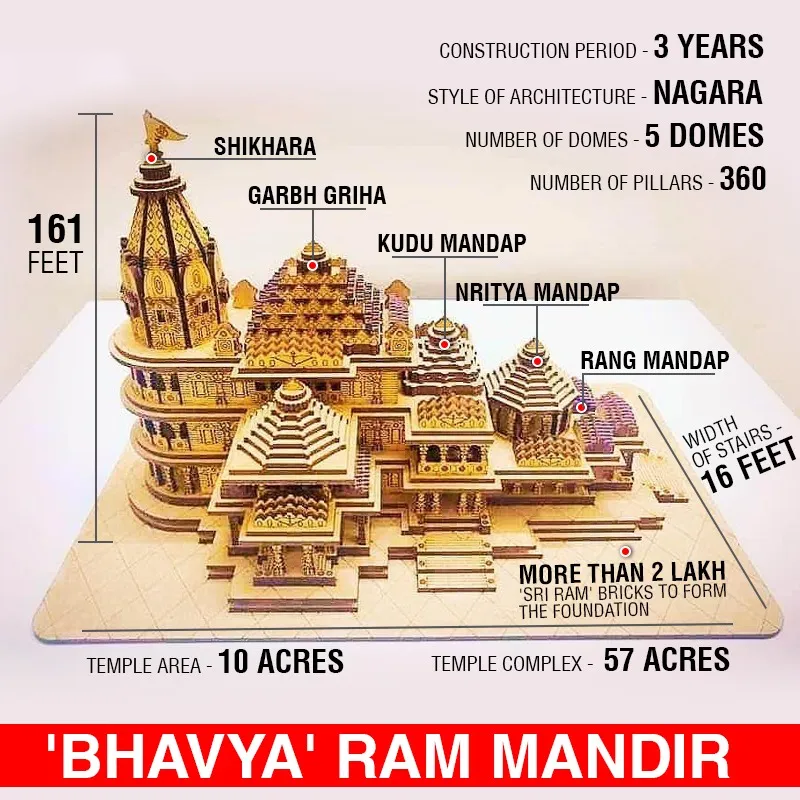
Introduction
With the Pran Pratishtha or consecration ceremony, a 500-year quest for an Ayodhya Ram Mandir concluded, marking a momentous occasion. This, according to the prime minister, is the culmination of a lengthy wait. He emphasized that fair and unbiased building methods were used to build the temple honoring Lord Ram, a symbol of justice. He thanks the Indian judiciary for defending justice’s fundamental values.
Even if the Ram Mandir has been built, the main goal is to keep religious conflicts in India from happening again. Everyone must respect Dharma and the precepts of Ram Rajya.
What is the Main Controversy Between the Babri Masjid and Ram Mandir?
- Babri Mosque constructed by Mir Baqi in 1529
- Ayodhya, Uttar Pradesh was home to the 16th-century mosque known as Babri Masjid. Many Hindus also hold the belief that Lord Ram (Shri Ram Janmabhoomi) was born at the mosque’s location.
- Ram Idol Appears inside the Mosque in Dec 1949
- Nirmohi Akhara filed a title action in 1959. The Ram Janmabhoomi’s legitimate manager, according to the Nirmohi Akhara, is itself.
- The complaint was also brought in 1961 by the Sunni Waqf Board, commonly known as the Uttar Pradesh Sunni Central Board of Waqfs. The Board asserts that it owns the mosque.
- Senior attorney Deoki N. Agarwal filed a lawsuit at the Allahabad High Court in 1989 on Lord Ram’s behalf. Every earlier lawsuit was transferred to the High Court.
- Rath Yatra on September 25th, 1990
- To rally support for the Movement, LK Advani starts a Rath Yatra from Somnath, Gujarat, to Ayodhya, Uttar Pradesh.
- Babri was demolished on December 6th, 1992
- The Babri Mosque was destroyed by a furious Karsevak mob. In its stead, the Karsevaks leave behind an improvised temple.
- State acquires Ayodhya land on January 7th, 1993
- An ordinance is issued by the government to purchase 67.7 acres of property.
- April 2002
- The Ayodhya Title Dispute is being heard by the Lucknow Bench of the Allahabad High Court.
- January 8th, 2019
- CJI listed the case before a five-judge Constitution Bench using his administrative authority.
- Supreme Court orders mediation on March 8th, 2019
- The Constitution Bench mandates mediation under judicial supervision.
- Supreme Court delivered its final verdict on November 9th, 2019
- By a majority decision, the Supreme Court resolved the issue by awarding the 2.77 acres of contested property for the construction of a temple honoring one of the three claimants in the case, the god Ram Lalla.
- The court also set aside five acres for the construction of a mosque at a prominent location in Ayodhya in addition to the site for the temple.
What Justified the Supreme Court’s Decision to Support Ram Mandir Construction?
- Competing Rights over the Disputed Site
- Muslims and Hindus each held conflicting claims to the contested location. However, the Hindus’ more convincing proof of their ongoing worship at the contested structure played a significant role in the Court’s ruling.
- Lack of Exclusive Muslim Possession
- The Muslim parties did not present any proof that their ownership of the contested edifice was exclusive or that Hindus were excluded from the namaz (prayer) offering.
- Possession of the Outer Courtyard
- The court observed that Muslims had never owned the contested site’s outer courtyard. Even though there were competing claims to the inner courtyard, Muslims did not leave the mosque until December 1949, when namaz was performed.
- Sunni Waqf Board’s Failure to Establish Ownership
- Another key consideration the Court took into account was the Sunni Waqf Board’s failure to demonstrate ownership through waqf (dedication by user) or adverse possession.
- Trust for Temple Construction
- The Center, which had obtained the contested land and surrounding territories, was ordered by the Supreme Court to establish a trust to proceed with the construction of the temple. This was a component of the decision that settled the conflict and made it easier to build the Ram temple there.
- ASI Report
- The Archaeological Survey of India (ASI) report was cited by the Supreme Court in its ruling, noting that the Babri Masjid, which was erected on the disputed site and demolished in 1992, was not constructed on vacant land and that there was proof of the existence of a temple-like structure on the property before the mosque’s construction.
- Doctrine of Essentiality
- The theory of necessary religious activities was utilized by the Supreme Court in rendering its decision. It referred to the 1994 decision of M. Ismail Faruqi v. Union of India, in which the Supreme Court ruled that Muslims might give namaz (prayer) anywhere, including in public, and that a mosque was not a necessary component of practicing Islam.
Also read: Ayodhya Ram Temple: A Triumph of Faith
Why Is the Construction of the Ram Mandir Important?
- Moment of Triumph
- An important development that ushers in a new era in Indian history and puts an end to a protracted conflict is the construction of the Ram Mandir at Ayodhya.
- Religious Significance
- The temple is the hallowed residence of Ram, one of the most well-known gods in the Hindu pantheon, who is said to have been born at this precise location in Ayodhya.
- Symbol of Faith
- On what many Hindus consider to be the birthplace of Ram, Ram Mandir is now under construction. The majority of Hindus retain idols of Lord Ram in their homes, and millions of them worship him with the deep belief that repeating his name would bring prosperity and calm in difficult times.
- Temple Economy
- Because of improved connection, these measures are projected to elevate Ayodhya to a prominent spiritual hub in the nation, while stimulating commerce and economic activity across the surrounding area.
- Nucleus Institution
- The temple could serve as the foundation for the expansion of philanthropic organizations like hospitals and schools.
- Social Cohesion
- The Ram temple will convey a greater message of unity and cultural harmony than just the symbolism of a Hindu god. It is the use of divinity to manipulate society. It could end up serving as the nation’s unifying factor.
- Cultural Diplomacy
- In addition to being a major theological influence in India, Ram’s divinity is also deeply ingrained in the cultural legacies of countries like Thailand, Indonesia, Myanmar, and Malaysia.

How can a Democracy such as India Possess the Principles of Lord Rama?
- Promoting Dharma (Righteousness)
- Urge public officials and individuals to live morally and ethically upright lives in all spheres.
- Stress the value of being truthful, honorable, and equitable in both private and public interactions.
- Justice and Fairness
- Provide a strong, unbiased legal system that guarantees justice to all citizens, regardless of their circumstances.
- Encourage equitable treatment and equal opportunity for all people, regardless of their socioeconomic background, caste, or religion.
- Inclusive Governance
- Encourage the development of an inclusive political system that reflects the many viewpoints and views of the populace.
- Promote laws that attend to the needs of underprivileged groups so that the advantages of growth are felt by all facets of the community.
- Servant Leadership
- Encourage the notion that leaders should be people’s servants, with an emphasis on the growth and well-being of the community.
- Motivate political leaders to be modest, compassionate, and dedicated to serving the public good.
- Community Harmony
- Stress community cohesion and peace while shunning polarizing factors that might spark disputes.
- Promote communication and mutual comprehension amongst various populations, cultivating an atmosphere of acceptance and harmony.
Conclusion
As presented by the Prime Minister, there would be physical as well as verbal means to bridge the gap between Ram and Rashtra. Outreach to the minority population, those who disapproved of the Mandir movement, and everyone who is still uneasy about the consequences of temple consecration will all be necessary. In this polarized age, it will necessitate a determined search for common ground.
Frequently Asked Questions(FAQs)
What is Ram Mandir explained?
In Ayodhya, Uttar Pradesh, India, work is underway on the construction of a Hindu temple known as the Ram Mandir, or Rama Temple. It is situated at the alleged birthplace of Hinduism’s foremost god, Rama, known as Ram Janmabhoomi.
Who is the person behind Ram Mandir?
Gujarati citizen Govind Kamabhai was thirty years old the last time he visited Ayodhya as a Karsevak, or religious volunteer, to destroy the mosque. Happily seeing the consecration of the temple where he had stormed a mosque thirty-one years earlier, Kamabhai regarded it as a beautiful conclusion.
What is the importance of Ram Mandir in Ayodhya?
The temple was constructed in one of the most contentious locations in India, taking the place of the Babri Masjid, a 16th-century mosque that was destroyed in 1992 by radical Hindus who thought it was the location of another Hindu temple. The incidents led to widespread community rioting that claimed thousands of lives.
What are the facts about Ram Mandir?
The temple was built in the traditional Nagar style, according to the Shri Ram Janmabhoomi Teerth Kshetra. It measures 161 feet in height, 250 feet in breadth, and 380 feet in length (east to west). According to the trust, the temple has three floors that are each 20 feet tall.
Sources:
- https://timesofindia.indiatimes.com/speaking-tree/daily-ecstasy/rams-triumph-exploring-the-power-of-responsibility/articleshow/107039187.cms
- https://economictimes.indiatimes.com/news/how-to/mokshdayani-sapt-puri-why-ayodhya-holds-a-prominent-place-among-the-seven-most-important-pilgrimage-sites-for-hindus/articleshow/107048810.cms?from=mdr
- https://www.nytimes.com/2024/01/22/world/asia/modi-india-ram-temple.html
- https://en.wikipedia.org/wiki/Ram_Mandir
- https://www.bbc.com/news/world-asia-india-68003095
- https://indianexpress.com/specials/ayodhya-ram-mandir/
- https://www.hindustantimes.com/ayodhya-ram-mandir-opening-ceremony
